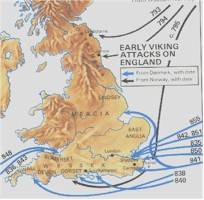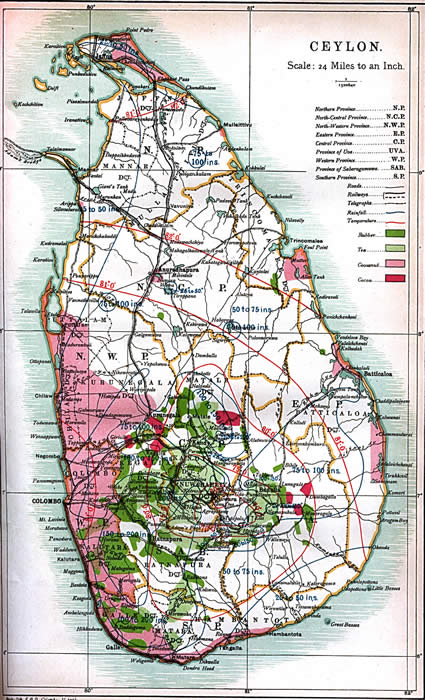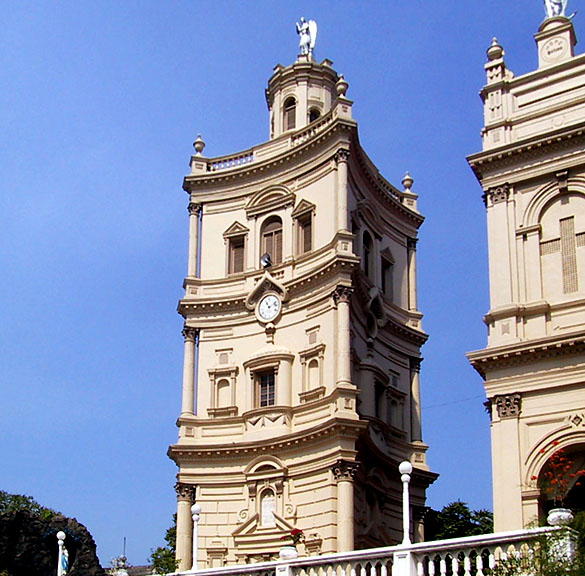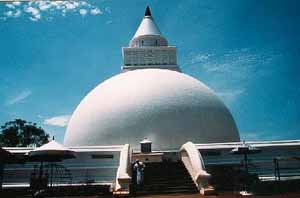Blaming the Past in Sri Lanka
by an historian
Blaming the past for all of Sri Lanka's current ills
has become fashionable. The convenient arch villain
has been identified as the Portuguese by some Sri
Lankan Pundits. The recently held "International
Conference on the 500th Anniversary of the Portuguese
Encounter at the prestigious BMICH in Colombo" is an
attempt in that direction.
If we can blame the
Portuguese for today's societal ills, then can the
Veddas, the Sri Lankan aboriginals, blame the Gujaratis
for their current plight? Because as Sri Lankan
children have been taught from their kindergarten, it
is Gujarat that gave birth to the Sinha[la] bahu clan
that has been directly instrumental in the cultural and
physical annihilation and genocide of the aboriginals.
In fact, I made the commentary to show how absurd it is
to blame the Portuguese for today's ethnic and social
problems. Many of the pundits in the conference
have conveniently forgotten to mention some of the
positive aspects of Portuguese colonization. These
positives were accrued mostly by the majority Sinhala
Buddhists who are decrying the effects today of Portuguese
colonization which happened more than 400 years
ago.
We can say very confidently that it is because of the
Portuguese colonization that the Sinhalese find themselves
as an overwhelming majority in Sri Lanka today viz a viz the Tamil minority. As Sri Lanka's written
historical annal, the Mahavamsa, mentions, ethnic Tamils
have found themselves in Sri Lanka in a
political culture that promoted Buddhism from the
beginning of written history. As a consequence, ethnic
Tamils have assimilated into Sinhala Buddhist identity at varying rates
since that time. It is no different than the invading
Normans and Danes, as well as the  indigenous Celts, becoming
English over a period time in England. Whether Tamils
were in Sri Lanka prior to this Gujarati colonization
or not is immaterial, because during this period the Sinha[la] Bahu clan
eventually imposed its cultural traits on everyone. indigenous Celts, becoming
English over a period time in England. Whether Tamils
were in Sri Lanka prior to this Gujarati colonization
or not is immaterial, because during this period the Sinha[la] Bahu clan
eventually imposed its cultural traits on everyone.
But this state of affairs did not last forever.
Long before the arrival of the Portuguese the Tamils
had been able to organize themselves as a separate
political entity under the auspicious of the Jaffna
kingdom. This kingdom was not restricted to the
northern Jaffna peninsula alone as biased contemporary
Sri Lankan history maps would indicate. It had
suzerainty over the pearl rich western Puttalam area
and further south as recorded by a traveling Chinese
historian Fa Hien of those days. This kingdom provided
the political space for Tamils to survive as a
separate ethnic group without the need to assimilate
as Sinhala Buddhist as they had done in the post-Gujarati colonization period.
Further, the coastal littoral of southern Sri Lanka was
inhabited by simple folk of South Indian origin whose
main livelihood was fishing, pearling, toddy tapping,
cinnamon peeling and being the cannon fodder of local
petty kings and chiefs in their constant fights.

These were, by and large, Tamil or Malayalee-speaking
Hindus as can be attested by the "Ge" or house names
of their descendants today in South Sri Lanka. Their
primary function of fishing and toddy taping had
prevented them, namely the Karave, Salagama & Durave
castes, from being absorbed into Buddhism as fishing
and toddy tapping were abhorrent functions to the
Buddhists.
Although some amongst these castes, due to their military
service, had ingratiated their lineages with the
dominant Sinhala Buddhists and received land grants. It is
this group that has turned out to be the true villains of
Sri Lankan history, not the Portuguese.
Although most of the descendants of these groups today
deny their obvious South Indian origins, true
historians know the truth. If left alone, most of these
coastal people would have coalesced into the Tamil
minority of Sri Lanka. If that had happened Tamils
might not have been the minority at all. But that is
not what happened. The most important contribution
that the Portuguese did to the Sinhalese was the
elimination of an important social distance indicator
between coastal Tamils and Sinhalese in converting
both to the Catholic faith. It enabled the age-old
assimilation of Tamils into Sinhalese to happen again, an assimilation
which had come to a halt due to political and
religious reasons.

Church in Galle with dagoba
As a caveat, during the Buddhist revivalist period
instigated by Anagarika Dharmapala, who was born into a
Catholic Salagama family, many of these coastal
Catholics both Tamils, Sinhalese and Sinhalised Tamils
converted enmass to Buddhism, and even created their
own Buddhist organizations because the traditional
upper Govi caste-oriented prelates refused entry of
these newly converted Buddhists of dubious caste
origins into their organizations.
Even today Sri Lankan Buddhist prelates are organized
by caste, such as the Govi, Karavae and Salagama, because of
this very reason. If there is to be a loser due to
Portuguese colonization in Sri Lanka, then it is the
Tamils more than the Sinhalese. Tamils lost their
independent Jaffna kingdom and lost a
very large percentage of their ethnic brethren to
Catholicism. These brethren have become Sinhalese Buddhist and
Sinhalese Catholics, all the way from western Puttalam
region to southern Matara and beyond. It is only in
the Northeastern provinces that Catholics have
maintained their Tamil identity.

St James the Greater, Colombo
Today just one village in the Western coast hangs on
to its Tamil identity. It is Uddappu, one of out
of a thousand villages and towns which spoke Tamil
and dotted the coastal region once upon a time. All
other surrounding Catholic or Buddhist villages are
self-considered to be Sinhalese, even if they spoke
Tamil at home just a generation ago.
Further down in
the South, Tamil has been replaced as a mother tongue
many generations ago. Although, as presented in the
conference, Portuguese did destroy many Hindu and
Buddhist places of worship, today's new Buddhists
have taken over many Hindu temples as Buddhist Vihares,
as can be seen by the statutes of the Hindu deity Ayyanar
on horseback in these Vihares' complexes close to
Negombo.
 Kataragama Kataragama
These new Buddhists, like all the newly converted around
the world, overwhelmingly supported, and still support,
the suppression of Tamil language and civil rights
since the populist prime minister Solomon West
Ridgeway Diaz Bandaranaike came to power in 1956. He
himself came from an uppity coastal caste of formerly
Hindu, then Catholic, and later Protestant background.
He converted to Buddhism as a way to gain power, only
to be shot dead by a Buddhist monk. In a nutshell, Bandaranaike's
family's ascent to power as Sinhala elites from their
lowly roots shows the hybridization that is the norm
amongst the Sri Lankan ruling class. Since Bandaranaike, his clan has
provided two more leaders for the country, who have
managed to push it beyond the abyss.
Sri Lanka has not being able to overcome its colonial
history, not because of the effects of colonialism, but because of the lack of vision of its post-colonial political class. This cabal owes its current
success to its ability to ingratiate itself with whoever
and whatever has been perceived to be dominant. This group has
appropriated whatever has been necessary to succeed.
During pre-colonial times, it was for land grants from
petty Sinhalese chiefs and titles for offering their
kinsman as the cannon fodder for war. During the
Portuguese times, the path to success was Catholicism and Portuguese
names. During the British time most converted
to Protestantism and picked up Anglo names. Today the same people
are Buddhists of the first class. Their continued
usage of racist supremacy as a political card displays
the inner insecurity of the ethnically hybridized
ruling class, but also - primarily - their crass
opportunistic behavior.
The entire top rung of the pseudo-Marxist, but
ideologically racist JVP (the third largest political
party) politburo hails from these coastal littoral
areas. Family origin in these areas lie in the murky waters off the
Palk Straits. Today these people are upkeepers of the
virulently superior Sinhala Buddhists interests. This
also applies to the current President and his coterie
of Southern advisors and military leaders with Iberian
patrilineal last names open or hidden.
It is this ruling class catering to a narrow,
parochial and racialist world view that has brought
the country to its current abyss, not Portuguese
colonialism as the conference presenters would have us
believe. The people who pay the price for such
opportunistic politics are the common family man, the
fisher and the farmer who have from time immemorial
wanted to live in peace and love with their neighbors,
true to their religious teachings, not the corrupt
Pajero-driving Swiss bank account-holding ruling
class.
If Sri Lanka is to emerge from its current abyss, then
its highly educated people need to look at who is
leading whom in what direction. Is the tired old
virulent Sinhala Buddhist rhetoric used originally by
the Diaz Bandaranaike clan and now being offered anew
by the Mahinda Rajapakses, JHU & JVP the right message
for them?
Who does this virulent and racist message benefit? It
only benefits the ruling class and their hangers-on that
have, like the chameleon, changed their colors to hold on
to their petty perks at the cost of millions of common
people. They have sacrificed the future of growth and
economic stability that was Sri Lanka's due like
in Singapore, Taiwan and Thailand just for their
selfish interests. Their ancestors sacrificed their kinsman for a few acres and useless
titles, and today's cabal of Hennanayakes, Rajapakses & de
Silvas are burying the birthright of all Sri
Lankans.
|
 Home
Home Archives
Archives Home
Home Archives
Archives